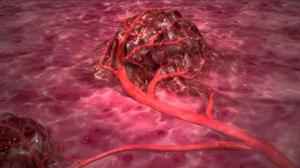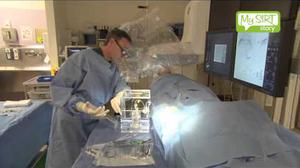
- Ablation: A form of cancer treatment that destroys cancer cells directly through heat (eg radio frequency and microwave ablation), cold (cryotherapy) or chemicals (ethanol injections).
- Angiogram: An image of blood vessels produced by an x-ray using a special dye (contrast medium).
- Benign (tumour): These are tumours that do not turn into cancer and unless they are causing symptoms, do not need to be removed.
- Biopsy: An examination of tissue removed from a living body to discover the presence, cause, or extent of a disease.
- Catheter: A tube that is inserted into blood vessels, passageways or body cavities to allow injection, withdrawal of fluids or to keep a passage open.
- Cholangiocarcinoma: Bile duct cancer.
- CT (Computerised Tomography) scan: A method that takes many x-rays to create a very detailed three-dimensional picture of inside the body. Also called a CAT scan.
- Embolise: A treatment that blocks the flow of blood in small blood vessels, such as those feeding a tumour.
- External radiotherapy: A method for delivering a beam of x-rays to a tumour. Beams are generated outside the patient and are targeted to the tumour site. No radioactive sources are placed inside the body.
- Femoral artery: A large artery that starts in the lower abdomen (tummy) and goes down into the thigh.
- Hepatocytes: Liver cells.
- Internal radiotherapy: A method for placing a small piece of radioactive material inside the body near the tumour to help destroy cancer cells.
- Interventional radiologist: Medical doctors who specialise in procedures that involve radiology including SIRT.
- Laparoscopy: A surgical procedure in which a fibre-optic instrument is inserted through the tummy wall to view the organs or to allow small-scale surgery, eg to remove a small piece of tissue for a biopsy.
- Liver cirrhosis: Scaring of the liver tissue that stops it from functioning properly.
- Liver shunting scan: This test is also known as a scintigraphy (sin-tig-raf-ee) or a MAA scan. It allows the doctor to predict where the microspheres will lodge themselves on the day of treatment and help to determine a safe dose of microspheres for you.
- Malignant: Tumours that are made up of cancer cells. They can destroy surrounding healthy tissue and spread to other parts of the body.
- Metastases: Cancerous cells that break-off from the original source of the cancer and travel to other parts of the body.
- Metastatic colorectal cancer (mCRC): Cancer that originates in the colon or rectum and has spread to the liver.
- Microspheres: Tiny beads.
- MRI (Magnetic Resonance Imaging) scan: A method that uses magnetic fields to build up a detailed three-dimensional image of inside the body.
- PET (Positron Emission Tomography) scan: A PET scan uses an injected mildly radioactive sugar that shows up where cancer cells are active in the body. A CT scan is then performed in a machine called a PET-CT to show where these radioactive 'cancer hot-spots' are located.
- Primary cancer: The place where the cancer begins.
- Prognosis: The prediction for the outcome or course of a disease.
- Radioembolisation: Another name for the SIRT procedure.
- Radiotherapy: The use of radioactive substances to destroy cancer cells.
- Resection: The surgical removal of part of a structure or organ.
- Secondary cancer: The place where cancer spreads to from its original source, for example, liver cancer that has spread from the bowel.
- Selective Internal Radiation Therapy (SIRT): A targeted treatment for liver tumours that delivers millions of tiny radioactive beads to liver tumours (also known as radioembolisation).
- SIR-Spheres microspheres: Tiny radioactive resin beads (microspheres) that are most commonly used in the SIRT procedure.
- Tissue: A part of the body of a living thing that is made of similar cells, for example liver tissue in your liver.
- Tumour: A lump of cancerous cells.
- Ultrasound scan: This test uses sound waves that bounce off your internal organs and tissues to create a picture of a part of the body.
- Yttrium-90: Yttrium-90, or Y-90, is the radioactive element that is attached to SIR-Spheres microspheres.

There are three ways in which you can get SIRT treatment:





























